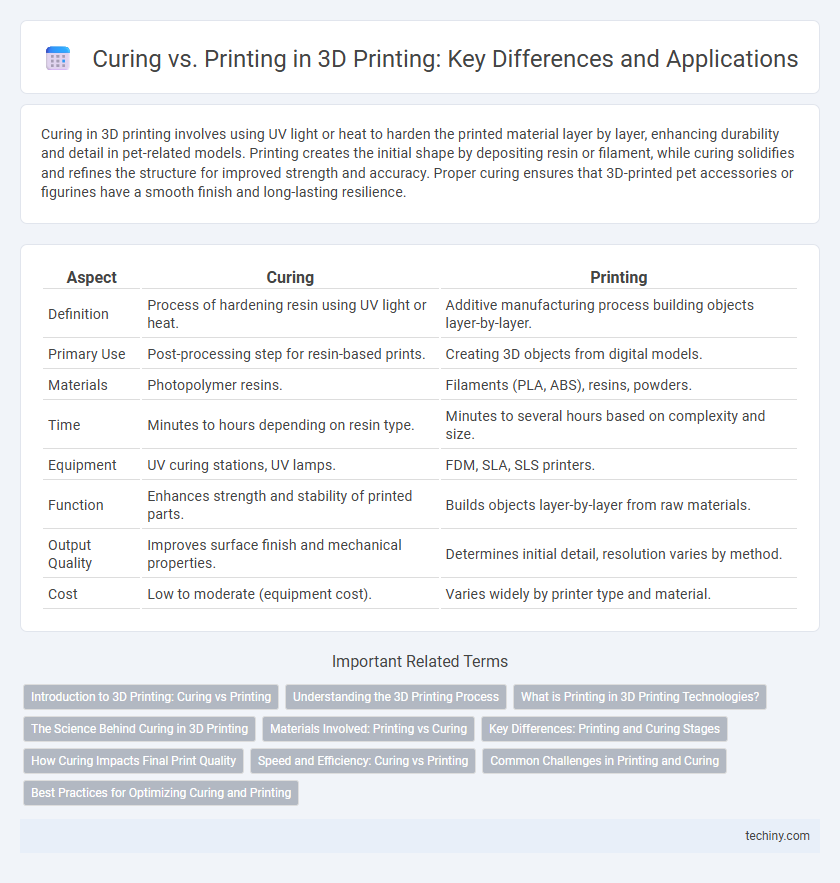Curing in 3D printing involves using UV light or heat to harden the printed material layer by layer, enhancing durability and detail in pet-related models. Printing creates the initial shape by depositing resin or filament, while curing solidifies and refines the structure for improved strength and accuracy. Proper curing ensures that 3D-printed pet accessories or figurines have a smooth finish and long-lasting resilience.
Table of Comparison
| Aspect | Curing | Printing |
|---|---|---|
| Definition | Process of hardening resin using UV light or heat. | Additive manufacturing process building objects layer-by-layer. |
| Primary Use | Post-processing step for resin-based prints. | Creating 3D objects from digital models. |
| Materials | Photopolymer resins. | Filaments (PLA, ABS), resins, powders. |
| Time | Minutes to hours depending on resin type. | Minutes to several hours based on complexity and size. |
| Equipment | UV curing stations, UV lamps. | FDM, SLA, SLS printers. |
| Function | Enhances strength and stability of printed parts. | Builds objects layer-by-layer from raw materials. |
| Output Quality | Improves surface finish and mechanical properties. | Determines initial detail, resolution varies by method. |
| Cost | Low to moderate (equipment cost). | Varies widely by printer type and material. |
Introduction to 3D Printing: Curing vs Printing
3D printing involves layer-by-layer fabrication, where printing refers to the additive manufacturing process of depositing material to build an object. Curing, a crucial step in resin-based 3D printing, uses UV light to solidify liquid resin, ensuring structural integrity and precision. Understanding the distinction between printing and curing is essential for optimizing print quality, speed, and material performance in stereolithography (SLA) and digital light processing (DLP) technologies.
Understanding the 3D Printing Process
3D printing involves both the additive process of building objects layer by layer and the curing stage, where each layer is solidified using UV light or heat to ensure structural integrity. Understanding the distinction between printing and curing is crucial for optimizing print quality, as incomplete curing can lead to weak or deformed parts. Effective control of curing parameters enhances material properties and dimensional accuracy in resin-based 3D printing technologies.
What is Printing in 3D Printing Technologies?
Printing in 3D printing technologies refers to the precise layer-by-layer deposition of materials to create three-dimensional objects based on digital models. This process involves various methods such as Fused Deposition Modeling (FDM), Stereolithography (SLA), and Selective Laser Sintering (SLS), each utilizing different materials and mechanisms to build parts. Printing is the foundational step that physically constructs the object, whereas curing is often a subsequent process that solidifies or strengthens the printed layers.
The Science Behind Curing in 3D Printing
Curing in 3D printing involves the polymerization process where photopolymer resins solidify upon exposure to ultraviolet (UV) light, forming strong and precise layers. This chemical reaction transforms liquid resin into hardened plastic, enhancing mechanical properties and dimensional accuracy. Understanding the curing parameters, such as light wavelength, exposure time, and resin composition, is essential for optimizing print quality and durability in stereolithography (SLA) and digital light processing (DLP) technologies.
Materials Involved: Printing vs Curing
Printing in 3D technology primarily involves depositing materials such as thermoplastics, resins, or metal powders layer by layer to form the desired object. Curing focuses on solidifying these materials, especially photopolymer resins, through light exposure--typically UV light--to harden and achieve structural integrity. Material properties during printing vary from fluid or semi-fluid, while curing transforms these into rigid, durable forms essential for the final product's functionality.
Key Differences: Printing and Curing Stages
In 3D printing, the printing stage involves the layer-by-layer deposition or solidification of material to create the object's basic shape, utilizing technologies like FDM, SLA, or SLS. The curing stage follows printing and focuses on hardening or strengthening the printed layers through processes such as UV light exposure or thermal treatment to achieve final mechanical properties and durability. Key differences lie in their functions: printing builds the structure, while curing reinforces it to ensure dimensional stability and material performance.
How Curing Impacts Final Print Quality
Curing in 3D printing, especially in resin-based processes, directly influences the mechanical strength, surface smoothness, and dimensional accuracy of the final print. Proper curing ensures complete polymerization, reducing brittleness and preventing deformation or shrinkage after print completion. Insufficient or uneven curing can lead to weak structures, visible layer lines, and surface imperfections that degrade overall print quality.
Speed and Efficiency: Curing vs Printing
Curing in 3D printing typically requires less time than the actual printing process, as it involves hardening a printed layer using UV light or heat to achieve dimensional stability. Printing speed depends on factors such as layer height, print resolution, and the complexity of the 3D model, often taking significantly longer than curing. Efficient 3D printing balances optimized printing parameters with rapid curing cycles to minimize total production time and improve overall workflow productivity.
Common Challenges in Printing and Curing
Common challenges in 3D printing and curing include managing material warping, inconsistent layer adhesion, and incomplete polymerization. Printing issues often arise from improper temperature settings, nozzle clogs, or filament quality, while curing problems typically involve uneven UV exposure or insufficient post-curing time. Optimizing print parameters and curing processes ensures enhanced dimensional accuracy and mechanical strength in final 3D printed parts.
Best Practices for Optimizing Curing and Printing
Optimizing curing in 3D printing involves selecting the right wavelength and intensity of UV light to ensure complete polymerization while minimizing warping and brittleness. Printing settings such as layer height, exposure time, and print speed must be finely tuned to match resin characteristics and the curing process for enhanced dimensional accuracy and surface finish. Regular calibration of printers and post-curing devices, combined with controlled environmental conditions, significantly improves the mechanical properties and durability of printed parts.
Curing vs Printing Infographic

 techiny.com
techiny.com